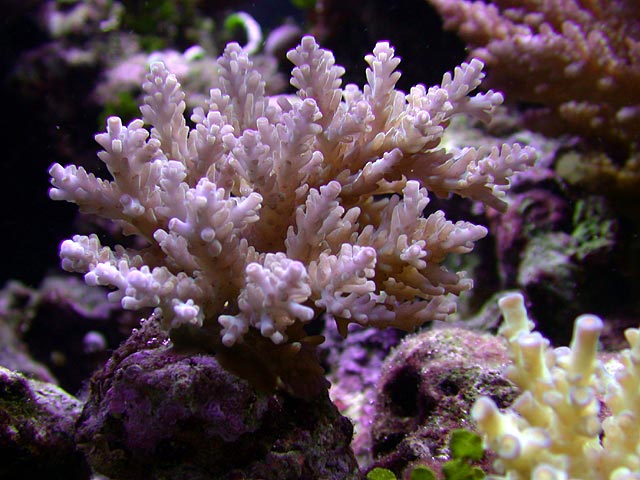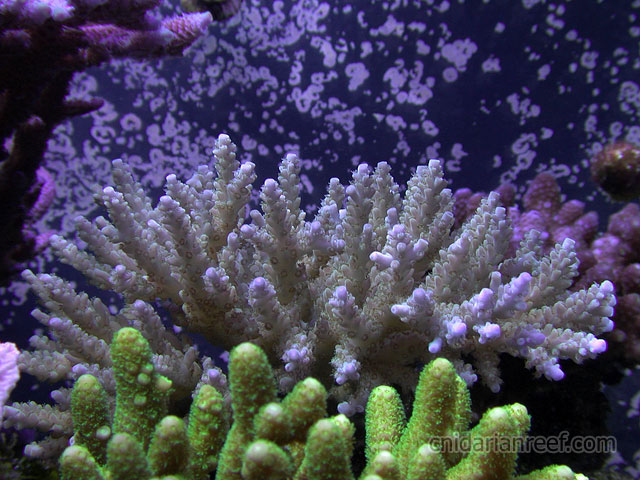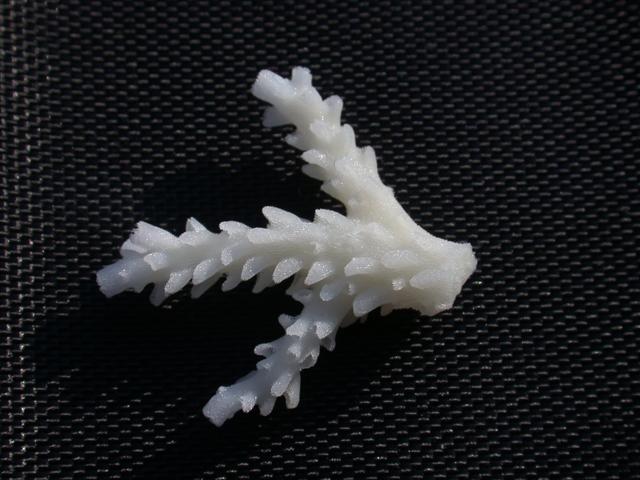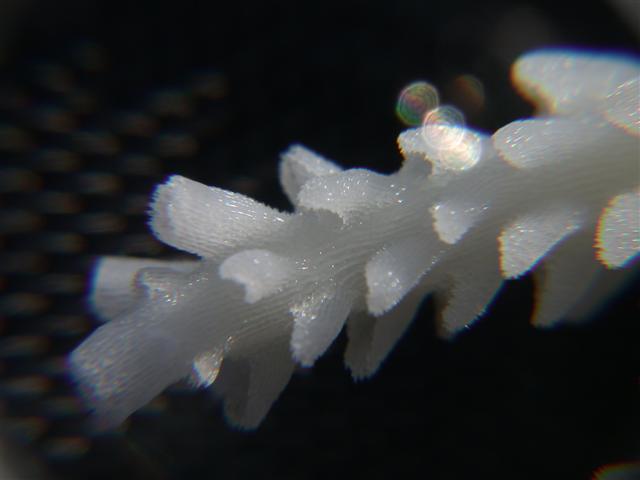

|
|
|
#1
|
|||
|
|||
|
Acropora ID mini-class
For anyone interested in participating, I am going to host a mini-class where you can get hands on experience in identifying Acropora. You will learn firsthand what it takes to try and assign a species name to this diverse genus.
I will not be able to provide holotypes of your corals, but we should be able to at least progress pretty far without it. Requirements: A representative branch from an Acropora colony you have kept. Ideally, you might want to pick one from a colony that is currently alive in your tank...and even better, one that was sold with a species name attached. I will need you to snip off a branch and put it in household bleach for a day until you have a nice bare skeleton. At that point, you might want to use some food coloring or iodine or something to lightly stain it to provide contrast, or you can leave it white. You will also need some sort of magnification device. A magnifying glass, hand lens, loupe, dissecting scope, etc. I will provide all the references you'll need. Optional: your own references. Time frame: We will begin in one week on Sunday, May 9, 2004. I suspect it will take about a week or two given the time between posts and normal internet-type board responses as well as your own abilities. There will be no class time...It will work just like a normal board thread with questions and responses. If you plan on participating, please have your selected Acropora branch ready by next week. There are no other requirements. It can be a frag, whole colony, wild, captive grown, any size, whatever. You will understand soon enough why I don't care anything more about the coral you choose ;-)
__________________
Eric Borneman |
|
#2
|
|||
|
|||
|
In fact, if you want to, you can even use a live branch or colony. If you do, your class time will be relatively short, but you'll still get the point.
__________________
Eric Borneman |
|
#3
|
|||
|
|||
|
Eric,
I'm looking forward to it. I only keep a couple, but I have one I'd like to try and identify. I'm a little lost how we will verify our attempts at identification. I have a digital camera of decent quality, but my skills at fine detailed macro shots, especially where it's difficult to get contrast (white skeleton), are lacking. I'm not sure what the word "Holotype" means, even with a definition: Holotype A single specimen designated as the name-bearing type of a species when it was established. In simple terms, the original specimen of a species. Usually abbreviated to 'type'.
__________________
Howard (It's the inlet side of a Mazzei Injector) |
|
#4
|
|||
|
|||
|
Holotype = known specimen filed with museums, etc.
How will you verify? Well, you can send it to me. I know I won't be able to do it from a photo, but the photos will help us with providing examples ofsome specific features.
__________________
Eric Borneman |
|
#5
|
|||
|
|||
|
Would a branch with an axial corallite be preffered for the branch to be studied? BTW,could you refer me to any sources where i could obtain a jewelers loupe or other magnifiying devices mentioned above?Looking forward to the class

|
|
#6
|
|||
|
|||
|
art supply store should have them - camera store, hobby store, office supply store, even WalMart type stores maybe. Magnifying glass would be fine, I think....sort of ;-)
You will need a representative branch, and yes, axials are important. In other words, pick one that is typical of the colony, if from a colony.
__________________
Eric Borneman |
|
#7
|
|||
|
|||
|
Quote:
 . .
__________________
Howard (It's the inlet side of a Mazzei Injector) |
|
#8
|
|||
|
|||
|
Or American Science and Surplus
__________________
Eric Borneman |
|
#9
|
|||
|
|||
|
Eric
 I got some members from another board to take the ride also 
__________________
If you See Me Running You Better Catch-Up An explosion can be defined as a loud noise, accompanied by the sudden going away of things, from a place where they use to be. |
|
#10
|
|||
|
|||
|
Quote:
I'd love to participate, but I think I already know the results (not to be presumptuous).  Eric, are you trying to halve the number of new threads in your forum? 
__________________
I'll shut up now... |
|
#11
|
|||
|
|||
|
Something tells me I'll have to practice my amazing abilities at jumping to conclusions

__________________
-Joe |
|
#12
|
|||
|
|||
|
Graham: Yes and No. I mean, if you have never really sat down and tried to do it, it's really quite an experience. It's like a jigsaw puzzle and fun and challenging and time consuming and enlightening. At least, that's how I find it to be.
__________________
Eric Borneman |
|
#13
|
|||
|
|||
|
This sounds exciting, will it be conducted here at RC?
|
|
#14
|
|||
|
|||
|
I think it will turn out to be an exercise resulting in a profound feeling of humility...(edit).....almost...futility.
__________________
John |
|
#15
|
|||
|
|||
|
Right here, on this thread. Starting tomorrow. I'll make my first post in the morning.
__________________
Eric Borneman |
|
#16
|
|||
|
|||
|
OK, you guys ready?
For the most part, I will be using the following reference: Wallace, Carden C. 1999. Staghorn Corals: A revision of the genus Acropora, CSIRO publishing, Queensville, Australia. 421 pp. I may also use: Veron, J.E.N.. 2000. Corals of the World. Volume 1. AIMS, Townsville. pp. 176-443. Veron, J.E.N., and C.C. Wallace. 1984. Scleractinia of Eastern Australia Vol 6, Part 5: Acroporidae. AIMS, Townsville. 485 pp. Wallace, CC., and J Wolstenholme. 1998. Revision of the coral genus Acropora (Scleractinia: Astrocoeniina: Acroporidae) in Indonesia. Zool J Linnean Soc 123: 199-384. Wallace, C, and M. Aw. 2000. Acropora staghorn corals: A "getting to know you" and identification Guide, Indian Ocean: Southeast Asia: Pacific Ocean. OceanNEnvironment Ltd, Australia. 128 pp. and any other specific articles or texts on Acropora that I have, as necessary. Background: Species boundaries in corals were highlighted in JEN Veron's book, Corals in Space and Time. Hybridization, plasticity of growth form, and other factors makes the taxonomy of corals quite difficult in many cases. Acropora is the largest extant genus of hermatypic coral, comprised of 2 species in the Caribbean (and a third that is a hybrid - A. prolifera), and about 160-175 species in and around the greater Tropical Pacific and Indian Oceans. Acropora is also one of the most widespread. There is considerable question as to the utility of using a Linnaean or Lamarckian categorization scheme in Acropora. That is, using morphology, growth form, and physical characteristics, along with variability, to assign species designations. Use of molecular techniques may show in the relatively near future that efforts to identify species using such classical systematics are too often wrong. But, that is what we have at present, and that is the focus of this class.
__________________
Eric Borneman Last edited by EricHugo; 05/09/2004 at 09:55 AM. |
|
#17
|
|||
|
|||
|
The genus Acropora can be broken up into two subgroups - Acropora and Isopora. The latter lack perisistent axial corallites. Examples of these would be the elkhorn coral, A. palmata in the Caribbean, and the cat's paw coral, A. cuneata and A. palifera in the Indo-Pacific. One might make the argument that in A. palmata, there is a lack of persistent radial corallites, too! To me, they all look like axials. Acropora, incidentally, is characterized by the appearance of this special terminal polyp that is housed in a generally elongated corallite called the axial corallite.
Other thigns to know: any "species" of Acropora can vary in its skeletal morphology - by geographic location, environmental conditions, age, size, season, mechanical impacts, hybridization, etc. Therefore, the single colony you have chosen might or might not be indicative or typical of the species. This will become clear as we begin to look at your specimens. So, before going much further, let's look at some basic terminology. I am going to list a lot of terms we have to be familiar with before going further. Growth form of the colony: Acropora develops as a consequence of the extension of axial corallites, budding of radial corallites, development of new axial corallites, and subsequent branching. Colony growth form varies from a little to a lot, and various growth forms may occur within a colony, within a species, and between species. digitate - colonies have short, non-dividing, non-anastomosing branches (like fingers of a hand) hispidose - colonies have numerous short side branchlets projecting outwards from the mainbranch corymbose - colonies consist of horizontal anastomosing branches and short upright branchlets tabulate or plate-like - colonies are flat, either with one cental stalk (leg) or attached to the substrate at one side arborescent - tree-like branches caespitose - colonies are bushy and branches interlock (anastomose) similarly in three dimensions massive - colonies are solid and similar in all dimensions other colony growth forms than could be used: cushion-like - colonies consist of fine branches that grow into the shape of a cusion encrusting - colonies encrust the substrate, sometimes with short branchlets projeting upwards prostrate - colonies sprawl across the substrate staghorn - colonies composed mainly of large antler-like upright branches thickets - colonies consist of closely compacted upright branches columnar - colonies form columns Any given specimen may have more than one colony growth form, and may not fit specifically into any one of these categories. In the case of aquarium corals, generally the colonies are very small and the growth form that might develop in a larger and more mature colony is not yet apparent. With fragments, such as by propagation efforts, this is certainly the case. So, step 1 in this class is to try and assign a growth form to your specimen, if it can be done. If it has multiple characters, list them all. Skeletal features axial corallite - the central corallite that determines the axis or growth on an Acropora. It often lies at the end of a branch, though axials and incipient axials may also form along the sides of branches, or on the surface of plates and encrustations. We will cover the axial corallite in depth in the next few days. radial corallite - peripheral corallites that like arranged around the axials, often on the sides of branches or between axials on plates and encrustations. Sometimes, they look very much like axials. We will cover the radial corallites in depth in the next few days. coenosteum - the skeletal matrix that lies between the corallites but not part of the axial or radial corallites. Often, the boundary is indistinct. Step 2 in this class is to examine your colony or branch and determine where the axials are, where the radials are, and where the coenosteum is. Also, if using a branch, see if you can determine if there are axials corallites that are incipient. Axials along branches may be in the process of forming from radials. Tomorrow, we will examine axial corallites. Then, we will examine radial corallites. Then coenosteal features. Then we will try and use those keys to break down our specimen into subgroups. Then we will use a systematics key to try and determine the species. In the next post, I will put some photos of the Acropora I am using. I will basically be doing this along with all of you as this is a specimen which I have not identified to species yet, so I am as clueless as to what it might be as you guys are with yours. Next, if you will, please let me know a bit about your choice, why you chose it, background of the coral, assumed identity, etc. Also, please ask questions about anything as we go along. Please post photos if you want for confirmation or discussion of your particular specimen, too.
__________________
Eric Borneman Last edited by EricHugo; 05/09/2004 at 09:54 AM. |
|
#18
|
|||
|
|||
|
I would call my colony digitate and clump-like
I would also say this colony is probably about 3-4 years old. Sorry about the pet hair, but this is what happens when you have dogs and cats around ;-)
__________________
Eric Borneman |
|
#19
|
|||
|
|||
|
These is the gross appearance of a branch from the colony with some features identified.
__________________
Eric Borneman |
|
#20
|
|||
|
|||
|
Here is the coral I will be using.
Picture when first acquired.  After 9 months.  Hispidose growth form? Picture of the branch I will be using that has been cut and left in bleach. Overall branch.  Close up of main branch showing axial corallites and radial corallites as well as coenosteum. (I'll try to edit it tonight to point to the features.) 
__________________
-Joe |
|
#21
|
|||
|
|||
|
Here is one I would like to identify. A whole colony was brought to a PSAS meeting and this image is of my fragment of that colony. It has encrusted on rock at the very back of the tank and cannot be readily removed to be photographed so the image here is poor. The fragment was mounted on it's side and instead of starting new growth from it's upper side coralites(what I expected), the existing axial coralites are bending up as they grow.
As I recall, there was a lot of anastomosing branches on the colony, especially in the lower, older, regions. The tips of the entire colony rose up to an even level like a tabletop, but this may be because they had reached the top of the water in the tank, I don't know. A form description that best applies - I would say - is corymbose. The anastomosing branches were generally in the lower, horizontal region and they terminate in short, upright branchlets. My fragment picured here is just an upright branchlet (mounted on it's side). An image of a skeletal tip follows this post. I apologize for attaching photos rather than links, but the RC upload to gallery function is currently broken. *edit* The upload image fuction also appears to be broken to attach images directly to a post. Hmmm.... I'll have to post back with links. Sorry.
__________________
Howard (It's the inlet side of a Mazzei Injector) |
|
#22
|
|||
|
|||
|
JB - looks like you have a fairly regular corallite distribution...should be a good choice (in contrast to mine!)
I would call yours caespitose to corymbose. Hispidose corals have fine branches off the main branch. A classic example would be something like A. echinata. howard - looking forward to seeing your photo. I will post the axial information in a while.
__________________
Eric Borneman |
|
#23
|
|||
|
|||
|
I uploaded the photos to Reef Frontiers. Hopefully you'all can access them.
A fragment of the colony A skeletized tip of the fragment
__________________
Howard (It's the inlet side of a Mazzei Injector) |
|
#24
|
|||
|
|||
|
Quote:
Quote:
Actually I find this first part, IDing the type of growth form, for some reason very difficult for me. Like why would you think that the coral I chose has a corymbose growth form. Wouldn't that kind of growth be similar to a classic table such as A. cytherea and A. hyacinthus?
__________________
-Joe |
|
#25
|
|||
|
|||
|
JB it is hard, you're right. Its a subjective distinction in many cases, with overlap and variation made all the more difficult by the size of the colony. I would have said something very different from the first photo to the second, but as the colony developes, you see different characters. So, here is an image from Wallace 1999 that shows "idealized" growth forms. Would that it was this easy.
So, here is where familiarity with variation comes in. The definition is a "loose" one. Degrees of connectivity... well, look at the fusion of a common base brought by extreme anastomoses. But, tables like A. hyacinthus or A. cytheria are not corymbose. A. millepora is corymbose. But, when young, A. hyacinthus and A. cytheria might look corymbose, and others in the hyacinthus group even have corymbose characters as well-developed colonies. Mine is actually a cross between caespitose, caespito-corymbose, and digitate. I have a feeling the digitate nature might become less if the colony were larger. Your case exemplifies the change over relatively small time frames and sizes how deceptive ID of a small colony growth form can be. I have received numerous small colonies over the years that were sold as "tables" but really weren't. Fortunately, this is just one step in the "narrowing down" process, and it is either helps, or it doesn't. For most available in stores, it is probably mostly unhelpful. For those that have grown quite a bit in tanks, maybe a bit more helpful, depending on how determinate the growth form for that species is across environmental gradients.
__________________
Eric Borneman |
|
|